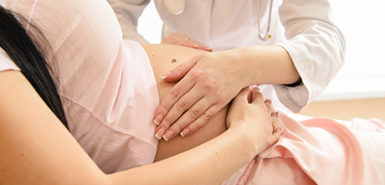
You’re 40 weeks and four days pregnant. You’re pretty sure you’re in labor.
You head to the hospital.
On the way, you see a McDonald’s sign up ahead. Should you stop and get that BigMac and fries? Why not a chocolate shake, too, while you’re at it?
What do you think?
This has never, and will never, be a recommendation.
For many years, women have been told that they should not be eating during labor.
Doctors feared complications from aspiration, especially if a cesarean section ended up needing to be done. (Aspiration is when contents from the stomach come up into the lungs.)
Ice chips were on the typical menu for women in labor.
This started back in the 1940s when hospitals used general anesthesia. Anesthesia has made many improvements in the past several years, and now only 6 percent of births involve general anesthesia.
Slowly, in the last few years, people have begun to question this idea of no food in labor.
After all, mom is doing a whole lot of work—hence the name labor!
Ch-ch-changes
Referencing a survey of mothers who gave birth in U.S. hospitals, Rebecca Dekker, PhD, RN, of EvidenceBasedBirth.com, said 60 percent of them said they didn’t drink liquids during labor and 80 percent said they didn’t eat. But when women are free to eat and drink as desired during labor—as is typically the case in freestanding birth centers in the U.S.— 95 percent of them choose to eat or drink, according to Dekker.
Clearly a new, much-needed change is happening.
Two years ago, the American Society of Anesthesiologists acknowledged that woman have traditionally been told to avoid eating or drinking during labor for fear they may aspirate.
The organization added: “Those they determine are at low risk for aspiration can likely eat a light meal during labor. This gives expectant mothers more choices in their birthing experience and prevents them from being calorie deficient, helping to provide energy during labor.”
This obviously tells us that light meals can be helpful to women in labor.
While the American College of Obstetricians and Gynecologists has not issued a change to its 2009 stance that prohibits solid food, the organization did say that “women with uncomplicated labor, as well as uncomplicated patients undergoing a planned cesarean, may drink modest amounts of clear liquids during labor if they wish.”
Many midwives still encourage light snacks during low-risk labor.
The American College of Obstetricians and Gynecologists issued changes that say not all women in labor may need an IV. The organization recommends oral intake for fluids and calories.
A very interesting report in 2017 showed that in 10 studies of a combined total of 3,982 women, moms who had fewer restrictions on eating and drinking had shorter periods of labor by 16 minutes. They also didn’t have a higher rate of cesareans or other issues.
I encourage my parents in childbirth class to talk to their provider about this, and to think about light snacks for labor.
Maybe it’s popsicles, a protein shake, something with a light protein and carb, granola bar, or things that give you a bit of strength but aren’t “heavy.”
I also encourage moms to bring snacks for dad. We want dad’s blood sugar to stay stable so he’s in good shape help to mom.
 /a>
/a>
 /a>
/a>
 /a>
/a>
Every time I am in labour we go to Tim Hortons for timbits to eat during labour and share with the birthing team. Luckily my Midwife was happy for me to eat at all even if it was Timbits 🙂 Better to have energy to keepup your strength than not eat at all and have failure to progress.
Thanks for sharing at #bloggerspotlight